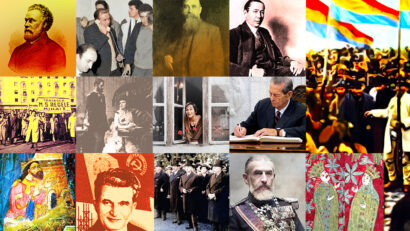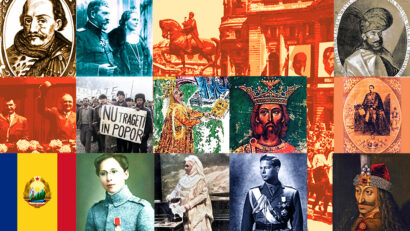Romania’s communists before communism
Before the installation of the communist regime, communist ideas had relatively little appeal in Romania.

Steliu Lambru, 17.08.2015, 12:53
Before the installation of the communist regime under Soviet occupation, the supporters of the communist ideology were seen as idealists. Although they made up a marginal group, their message was vocal because of the radical nature of the model they proposed. In Romania, communist ideas only appealed to a small public, and when communism became the official state ideology in Russia, they became even more marginal. Bolshevik Russia became Romanias main enemy, due both to the historical relations between the two countries and the aggressive policy of the Communist International, known as “Comintern. The supporters of communism in Romania before the installation of the communist regime were believed to be on the USSRs payroll and suspected of harbouring anti-Romanian sentiments.
Historian Adrian Cioroianu was the coordinator of a book containing the biographies of some of the Romanian communist leaders before 1945, when communism came to power in this country. Names like Vasile Luca, Gheorghe Gheorghiu-Dej, Petre Constantinescu Iasi, Ana Pauker, Nicolae Ceausescu and Petre Gheorghe were representative figures of the ruling power in Romania between 1945 and 1989. Adrian Cioroianu:
“In the countries neighbouring the Soviet Union, the number of communists was relatively low, perhaps also because of the fears concerning Russian expansionism. However, there were also different nuances to consider. In Romania, for example, the Communist Party had been banned as early as 1924, while Czechoslovakia had a bigger proletariat and a social foundation for the development of left and far-left politics. When looking at this period, I believe it is essential to make the distinction, when it comes to public discourse, between truth based on historical documents and preconceived ideas. In Romania before the installation of the communist regime, there were about several thousand people who, for one reason or another, believed in the future of the type of left-wing politics that was being experimented in the Soviet Union. We should not make the mistake of judging the 1930s from what we know today. We must accept the idea that just like in the case of the far right and the local legionnaire movement, which attracted many young people, a number of people, from lawyers to workers, had left-wing sympathies. They believed that the model adopted by the Soviet Union could usher in a better future.
Intellectuals, members of the middle classes, workers, all those who embraced the communist ideology did so for different reasons. For example, the Romanian intellectuals who applauded the Soviet Union were influenced by the West. Adrian Cioroianu explains:
“Paradoxically, these were people who followed the developments in the West very closely. The number of communists in the West was growing at the time, and people like Lucretiu Patrascanu and Petre Constantinescu-Iasi joined the communist movement by becoming members of a French trade union, as was also the case with Petre Constantinescu-Iasi. Lucretiu Patrascanu became acquainted with the works of various Russian authors through French translations. It must have been a sensitive issue for a Romanian with leftist ideas in the 1930s to see the communist movement thrive in the West, especially in France, which was a focus of interest for many Romanians. Of course it was easy to make the mistake of thinking that the progressist groups in the West were open to what was going on in Moscow. In the USSR, the Soviet propaganda machine worked flawlessly. We now know that well-established intellectuals from France and Britain, as well as pre-Hitler Germany and Italy, who were taken in by it. The same happened in Romania, albeit on a smaller scale. Of course, were not talking about hundreds of thousands of people, not even tens of thousands. We should be aware, however, that we wont find any records with the members of the Romanian Communist Party, because this party had been banned in 1924. So we will never know their exact number. The intelligence service of the then regime wanted to make it look like there were few communists in Romania, keeping a close eye on them but playing down their importance. During the communist period, many claimed they had been members of the Communist Party during the ban, much more than there had actually been.
Does the idealism of those who embraced the communist ideology make them exempt from any responsibility for what followed? Adrian Cioroianu:
“What we have written about in this book is the story of people who became very famous. These are well-documented cases, and today we know that each of these people, with the exception of Petre Gheorghe, also played a part in the events that followed after August 23, 1944. We look at their activity in the 1930s, but we cannot avoid talking about what happened afterwards, we cannot deny that they benefited from the events of the 1930s. Its part of their official biographies, and genuine myths were created around their lives. One such example is Nicolae Ceausescu, perhaps the most spectacular case of them all. Historians are walking on thin ice trying to establish the truth, as their number was not very large indeed but it was by no means as small as we would like it to be. Were not talking here about only 800 people, as has been commonly believed, and neither about 1,000 people. Our research points to several thousands. Its difficult to say how many of them were socialists and how many communists. During their trials many of them denied any connection with the communist movement, only to state exactly the opposite when the communists came to power in the 1940s.
The Romanians who had been communists before communism was officially instated in the country were compared to a messianic sect, a subversive organisation with mystical beliefs in spite of their atheism. History has proven that they knew how to be pragmatic as well when the time came.






























